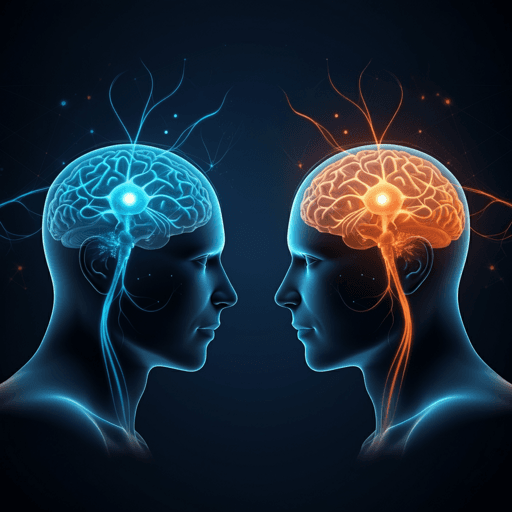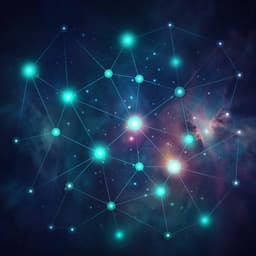
Psychology
What Else Is Happening to the Mirror Neurons?—A Bibliometric Analysis of Mirror Neuron Research Trends and Future Directions (1996–2024)
Y. Sun, N. Yu, et al.
This bibliometric analysis (1996–2024) maps the trajectory of mirror neuron research—peaking in 2013—highlighting core topics like intention understanding, affective empathy, motor learning, autism, neurostimulation, and emerging importance of BCIs and AI-integrations, and traces methodological shifts from electrophysiology to fMRI, TMS, and BCIs. Research conducted by Yangyang Sun, Ningyao Yu, Guanchu Chen, Tongwei Liu, Shengjun Wen, and Wei Chen.
~3 min • Beginner • English
Introduction
The paper addresses the trajectory and evolving focus of mirror neuron research since its discovery in the early 1990s. Mirror neurons, identified in premotor and parietal cortices of macaques and implicated across human brain regions, are activated during both action execution and observation and have been linked to social cognition, language, imitation, empathy, and neurological disorders. Despite a perceived decline in the "mirror-neuron brand" after a publication peak in 2013, bibliometric indicators and large citation counts show the field remains vibrant. The authors argue for a comprehensive scientometric overview to clarify development, research clusters, and trends. Objectives: (1) examine the literature cluster related to mirror neurons across the last three decades; (2) analyze changes in focus and evolutionary trends; (3) identify core topics and future directions.
Literature Review
The paper synthesizes foundational and critical perspectives on mirror neurons. Early work by Rizzolatti and colleagues established mirror properties in monkey premotor cortex (F5) and related areas, with subsequent evidence suggesting analogous mechanisms in humans. Reviews (e.g., Rizzolatti & Craighero, 2004; Rizzolatti & Sinigaglia, 2010, 2014) consolidated the role of parieto-frontal circuits in action understanding and imitation. Counterarguments, notably Hickok (2014), challenged the scope of mirror neurons in high-level action understanding and advocated broader frameworks (e.g., predictive coding) involving prefrontal and somatosensory systems. More recent analyses indicate mirror regions contribute to low-level action processing rather than high-level intention decoding (Wurm & Caramazza, 2019; Pomper et al., 2023), and observational learning involves complex interactions beyond the MNS alone (Ramsey et al., 2021). Expanding literature links mirror mechanisms to empathy and social behavior across species, including ACC and hypothalamic emotional mirroring in rodents, and highlights cerebellar involvement in reconstructing action sequences and predictive motor control, suggesting an extended cortical-subcortical network.
Methodology
Data source: Web of Science Core Collection (WoSCC). Search query: TS=("mirror neuron*"). Inclusion period: January 1, 1996 to December 31, 2024. Exclusions: books and book reviews, corrections, editorial materials, letters, conference papers, news items, proceedings papers. Duplicates removed; total included for visualization: 4054 records (3509 articles; 545 reviews). Metadata extracted: country/region, institution, journal, impact factor, references, year, total citations, authors, keywords. Export format: plain text with complete records and cited references. Screening: three reviewers independently screened titles/abstracts; disagreements resolved via discussion. PRISMA counts: records identified (n=4719); duplicates removed (n=7); screened (n=4712); excluded (books n=33; book reviews n=19; conference papers n=2; corrections n=10; editorial materials n=209; letters n=25; meeting abstracts n=120; news items n=5; proceedings papers n=230); reports sought (n=4059); not retrieved (n=5); eligible records (n=4054). Tools: VOSviewer v1.6.20 for collaboration network analysis (countries, authors); CiteSpace v6.2.R6 for institutions, journals, co-cited references, keyword networks, bursts, and cluster timeline views. Network visualization: node size reflects publication volume or keyword frequency; colors indicate clusters; proximity denotes relationship strength. Burst detection identified references and keywords with sharp attention increases over time. Keyword clustering: 11 clusters extracted; 9 analyzed after excluding broad clusters labeled "mirror neurons" and "mirror neuron systems" to avoid overlap.
Key Findings
Output trends: Publications peaked in 2013 (307 articles). Citations rose exponentially until 2013, then plateaued, with a downward trend starting in 2021; research depth and impact continue to grow. Geography: 70 countries/regions; European and North American dominance. Top publishing countries: United States 1151 (28.39%), Italy 765 (18.87%), England 545 (13.44%), Germany 439 (10.83%), France 236 (5.82%), Japan 235 (5.80%), Canada 216 (5.33%), Netherlands 200 (4.93%), China 181 (4.46%), Australia 168 (4.14%). Institutions: University of Parma 222; University College London 115; University of California, San Diego 80; University of California, Los Angeles 78; Radboud University Nijmegen 68; University of Southern California 66; Harvard University 65; University of Oxford 58; Max Planck Institute for Human Cognitive and Brain Sciences 47; University of Padua 46. Co-cited journals (top): NeuroImage 2879; Trends in Cognitive Sciences 2547; Science 2498; Neuropsychologia 2360; Brain 2328; Journal of Neuroscience 2270; PNAS 2256; Nature Reviews Neuroscience 2233; Experimental Brain Research 2192; Cerebral Cortex 2130. Co-cited authors (top): Rizzolatti 2938; Gallese 2241; Iacoboni 1829; Buccino 1265; Di Pellegrino 953; Fadiga 950; Decety 857; Keysers 809; Fogassi 786; Kilner 749. Highly co-cited references: Rizzolatti & Craighero (2004) most cited (734), and key works by Fogassi et al. (2005), Iacoboni et al. (2005), Rizzolatti & Sinigaglia (2010), Dapretto et al. (2006), Buccino et al. (2001), among others. Reference bursts strongest around foundational works (e.g., Buccino 2001, Rizzolatti 2004, Iacoboni 1999, Kohler 2002), later bursts include Cook 2014 and Rizzolatti 2014. High-frequency keywords: action observation (334), social cognition (193), theory of mind (148), transcranial magnetic stimulation (121), autism spectrum disorder (94), action understanding (87), embodied cognition (85), motor imagery (67), mu rhythm (63), premotor cortex (61), fMRI (58), social interaction (55), biological motion (52). Recent keyword bursts: brain-computer interface (2018–2024), autism spectrum disorder (2019–2024), virtual reality (2020–2024). Keyword clusters and themes: cognitive/social neuroscience (#0 theory of mind; #5 predictive coding; #6 embodied cognition, 208 keywords); motor neuroscience (#2 action observation; #4 action recognition; #7 motor imagery; #10 mu rhythm, 192 keywords); neurostimulation/technology (#8 virtual reality; #9 transcranial magnetic stimulation, 71 keywords). Methodological evolution: from electrophysiology and PET to fMRI, TMS, EEG, MEG, fNIRS, stereo/intracranial EEG, with multimodal integration. Emerging topics: integration with BCIs and VR; expanding clinical applications (stroke, ASD, bvFTD).
Discussion
The bibliometric mapping addresses the study’s aims by clarifying the evolution, hotspots, and influential entities in mirror neuron research. Despite a decline in the use of the label "mirror neurons" post-2013, the field has diversified and deepened, with interdisciplinary integration across neuroscience, psychology, motor science, linguistics, AI, and clinical rehabilitation. Foundational parieto-frontal accounts have been refined by critiques and newer evidence suggesting mirror areas support lower-level action features while broader networks (including cerebellum, basal ganglia, thalamus, prefrontal and somatosensory cortices) contribute to higher-level social cognition and prediction. The ripple effect extends to empathy and prosociality, with cross-species findings in ACC and hypothalamus supporting emotional mirroring and social behavior. In motor learning, action observation and motor imagery support cortico-spinal excitability and skill acquisition, with cerebellar involvement in sequencing and prediction indicating an extended MNS. Technological advances (fMRI/TMS/EEG/fNIRS; BCI and VR) have enabled precise measurement and translation into clinical protocols (mirror therapy and AOT for stroke, ASD diagnostics/interventions, bvFTD emotion recognition training). The results are significant for both theory—reframing the MNS within broader predictive and distributed frameworks—and practice—guiding neuromodulatory and rehabilitative strategies, and informing AI and human-robot interaction designs that leverage mirroring principles.
Conclusion
The study provides a comprehensive scientometric overview of mirror neuron research (1996–2024), highlighting a publication peak in 2013, sustained impact, and strong contributions from the United States and European institutions. NeuroImage and other high-impact journals, along with seminal authors (Rizzolatti, Gallese, Iacoboni, Buccino), anchor the field. Core themes span social cognition, motor learning, and neurostimulation technologies, with recent momentum in BCIs and VR. The coding properties of mirror neurons and their roles in empathy and intention understanding underpin clinical applications for ASD and neurodegenerative conditions and inform neurorehabilitation (mirror therapy, AOT). Future directions include integrating AI with mirroring mechanisms, advancing multimodal neuroimaging and neuromodulation, elucidating cerebellar-cortical interactions for sequence learning, exploring naturalistic contexts and consciousness/self-awareness, expanding cross-cultural/cross-species perspectives, and enhancing translational protocols via robot-assisted and VR-based interventions.
Limitations
The analysis relies on a single database (WoSCC), which may omit relevant literature; inclusion was limited to English-language publications, potentially excluding significant non-English research; rapidly evolving scholarship means the dataset may not capture the newest findings at the time of writing. Bibliometric techniques identify trends but do not assess methodological rigor, necessitating complementary systematic reviews. Future work should incorporate multiple databases (e.g., PubMed, Scopus), preprint servers, and multilingual sources to improve coverage and generalizability.
Related Publications
Explore these studies to deepen your understanding of the subject.







